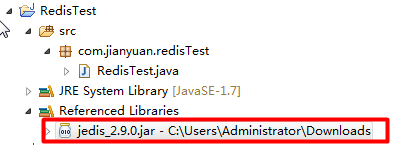1、首先下載jar包放到你的工程中

2、練習(xí)
|
1
2
3
4
5
6
7
8
9
10
11
12
13
14
15
16
17
18
19
20
21
22
23
24
25
26
27
28
29
30
31
32
33
34
35
36
37
38
|
package com.jianyuan.redisTest;import java.util.Iterator;import java.util.List;import java.util.Set;import redis.clients.jedis.Jedis;public class RedisTest {public static void main(String[] args) {//連接本地的Redis服務(wù)Jedis jedis = new Jedis("127.0.0.1",6379);//權(quán)限認(rèn)證jedis.auth("wenhongyu66");jedis.select(0);System.out.println("連接成功");//查看服務(wù)是否運(yùn)行System.out.println(jedis.ping());//設(shè)置 redis 字符串?dāng)?shù)據(jù)jedis.set("runoobkey", "www.runoob.com"); // 獲取存儲(chǔ)的數(shù)據(jù)并輸出System.out.println("redis 存儲(chǔ)的字符串為: "+ jedis.get("runoobkey")); //存儲(chǔ)數(shù)據(jù)到列表中jedis.lpush("site-list", "Runoob"); jedis.lpush("site-list", "Google"); jedis.lpush("site-list", "Taobao"); System.out.println(jedis.llen("site-list")); // 獲取存儲(chǔ)的數(shù)據(jù)并輸出List<String> list = jedis.lrange("site-list", 0 ,jedis.llen("site-list")); for(int i=0; i<list.size(); i++) { System.out.println("列表項(xiàng)為: "+list.get(i)); } // 獲取數(shù)據(jù)并輸出Set<String> keys = jedis.keys("*"); Iterator<String> it=keys.iterator() ; while(it.hasNext()){ String key = it.next(); System.out.println(key); }}} |
總結(jié):自己可以封裝一些工具類方便使用,包括連接池的配置,jedis參數(shù)的配置等。
|
1
2
3
4
5
6
7
8
9
10
11
12
13
14
15
16
17
18
19
20
21
22
23
24
25
26
27
28
29
30
31
32
33
34
35
36
37
38
39
40
41
42
43
44
45
46
47
|
private static JedisPool jedisPool = null;private static Jedis jedis; static { jedis = getJedisPool().getResource();} /** * 構(gòu)建redis連接池 */public static JedisPool getJedisPool() { if (jedisPool == null) { JedisPoolConfig config = new JedisPoolConfig(); config.setMaxTotal(1024); // 可用連接實(shí)例的最大數(shù)目,如果賦值為-1,表示不限制. config.setMaxIdle(5); // 控制一個(gè)Pool最多有多少個(gè)狀態(tài)為idle(空閑的)jedis實(shí)例,默認(rèn)值也是8 config.setMaxWaitMillis(1000 * 100); // 等待可用連接的最大時(shí)間,單位毫秒,默認(rèn)值為-1,表示永不超時(shí)/如果超過等待時(shí)間,則直接拋出異常 config.setTestOnBorrow(true); // 在borrow一個(gè)jedis實(shí)例時(shí),是否提前進(jìn)行validate操作,如果為true,則得到的jedis實(shí)例均是可用的 jedisPool = new JedisPool(config, "127.0.0.1", 6379); } return jedisPool;} /** * 釋放jedis資源 */public static void returnResource(Jedis jedis) { if (jedis != null) { jedis.close(); }}public static String get(String key) { String value = null; Jedis jedis = null; try { JedisPool pool = getJedisPool(); jedis = pool.getResource(); value = jedis.get(key); } catch (Exception e) { returnResource(jedis); e.printStackTrace(); } finally { returnResource(jedis); } return value;} |
RedisTemplate封裝了從JedisPool中取jedis以及返回池中
|
1
2
3
4
5
6
7
8
9
10
11
12
13
14
15
16
17
18
19
20
21
22
23
24
25
26
27
28
29
30
31
|
public class RedisTemplate { private JedisPool jedisPool; public RedisTemplate(JedisPool jedisPool) { this.jedisPool = jedisPool; } public <T> T execute(RedisCallback<T> callback) { Jedis jedis = jedisPool.getResource(); try { return callback.handle(jedis); } catch (Exception e) { // throw your exception throw e; } finally { returnResource(jedis); } } private void returnResource(Jedis jedis) { if (jedis != null) { jedis.close(); } }}public interface RedisCallback<T> { public T handle(Jedis jedis);} |
以上這篇redis在java中的使用(實(shí)例講解)就是小編分享給大家的全部?jī)?nèi)容了,希望能給大家一個(gè)參考,也希望大家多多支持服務(wù)器之家。















